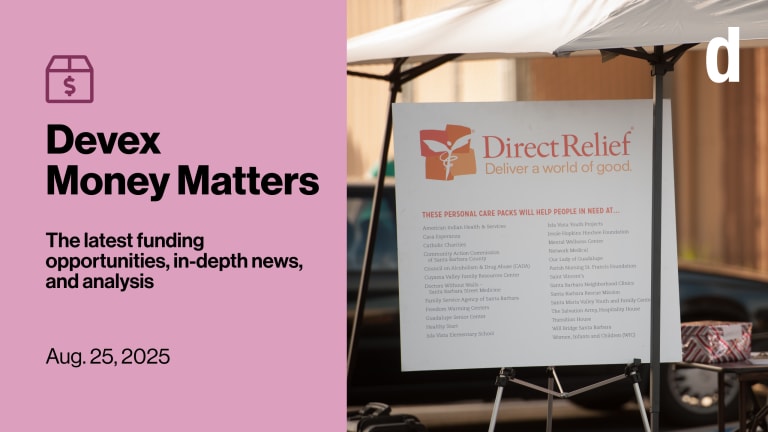Merlin: Anatomy of a doomed iNGO business model
Before deciding to merge with Save the Children, Merlin relied on a few traditional donors and received mostly “restricted” funds to work globally. Devex analyzes whether this business model can survive in a world where most aid groups are compelled to diversify their donor base to counter funding shortfalls.
In 2011, U.K.-based Medical Emergency Relief International received £68.9 million from its donors to fund its global operations which span 17 countries and employ about 4,000 staff. But what they got from them was not enough. With little money raised from private sources and other partnerships, Merlin overspent that year to make sure projects earmarked by traditional donors were kept running. The charity took cash out of its depleting reserves to cover the deficit. Over the past years, and in an era of donor budget cuts, the NGO has been relying on its very small pool of top donors who supported the vast majority of its needs through tied funding. Merlin’s financial standing characterizes a new reality in development finance: Excessive dependency on a few donors and reliance on “restricted” contributions is dangerous for international NGOs in times of worldwide aid budget austerity. According to several aid groups consulted by Devex, a non-varied funding base exposes nonprofits to the risk that even the slightest funding cuts can push up programming costs and in the end, limit their capacity on the ground. Even multilateral agencies like U.N. Development Program are faced with this problem and are finding it increasingly difficult to look for stable, predictable sources of funding. So what are NGOs doing to stay afloat? Most of them are trying to maintain a solid base of traditional funders while exploring partnerships with alternative and emerging donors to diversify their funding streams. But that is easier said than done. In the case of Merlin, contributions from private sources and donor partnerships just trickled in — and these past years, the list of contributors has gotten smaller and smaller. READ:Reinventing the international NGO Few top donors Since the organization was founded in 1993, Merlin has delivered medical services to some of the toughest places in the world, establishing itself in the niche sector of emergency medical response. Over these years, Merlin’s lifeline has been a small set of dedicated donors. In 2011, 70 percent of Merlin’s income came from six donors alone: European Commission, U.K. Department for International Development, U.S. Agency for International Development, United Nations, Irish Aid, and the Swedish International Development Agency. Last year, Devex spoke to then Merlin CEO Carolyn Miller, who said traditional donors were still there to help iNGOs and in the case of Merlin, she noted: “We don’t expect our traditional donors to go away, but [they] become a smaller proportion.” Over the past years, Merlin’s diversification strategy did not produce the expected results, and the organization saw a dwindling number of donors who provided just enough resources for its charitable activities worldwide. In 2010, 34 major funders (excluding an account that groups “other government funds”) supported Merlin. A year later, they were only 24. As their numbers got smaller, the share of the top six donors’ contributions continued to grow. Shrinking pool of sources Although most of Merlin’s big donors did not cut funding between 2010 and 2011, Irish Aid and many other important contributors pulled out their money. Between 2010 and 2011, (the latest fiscal years when Merlin submitted financial statements), Mercy Corps, McCall MacBain Foundation and Academy for Education Development decided not to give Merlin any funds at all. Other donors drastically cut funding, like the Global Fund to Fight AIDS, Tuberculosis and Malaria, which was once Merlin’s major donor, providing £2.8 million or six percent of Merlin’s needs in 2009. But just two years later, the organization received only £237,350 from the Fund, or 0.34 percent of its total income. Finding a predictable stream of funding is quite a challenge for any iNGOs working in times of disasters and humanitarian crisis, and like any other aid group, Merlin’s contributions fluctuate depending on the appeals it launches and donors’ response to humanitarian crises. Hands off To stay viable in a stiffening competitive market of iNGOs, Merlin decided to mostly target projects already fully earmarked by donors. “Merlin is implementing a substantial portfolio of confirmed donor-funded projects overseas,” the group said in its 2011 financial statement. And in 2010 and 2011, about 90 percent of its income was restricted to projects identified by donors, not Merlin. These earmarked projects usually incur additional administrative and reporting costs which NGOs charge to their unrestricted fund pool or reserves funds. In other projects, donors require counterpart funding from partners who may either raise the money from other donors or access it from their reserves. Relying on project-based funding may eventually hurt nonprofits, several NGO sources told Devex. These groups said projects entail additional costs like staffing, and without enough money from the untied pool to cover the additional expenses, NGOs have to shoulder the full cost. In 2011, Merlin incurred a loss of £1.9 million because the income that went through the unrestricted pool was not enough. NGOs explain that in times of budget crunch in the developed world, nonprofits have to aggressively eye funding from wealthy individuals, private foundations, previously untapped government donors and philanthropists, among other sources. But the charity struggled to attract funding from new sources these past years. Merlin has repeatedly identified “fundraising in a difficult economic environment” as one of its main risks. To fund those deficits, Merlin tapped its shrinking reserve funds: from £9.3 million in 2009 to £7.1 million just two years later. Most of the time, Merlin has run into cash flow troubles because of the earmarked projects it has with its donors. Since its fund reserves are not enough to finance its multimillion charity activities worldwide, the organization would try to get bank loans. “The very nature of the agreements with these donors requires the organization to regularly pre-finance much of its overseas charitable work in advance of the receipt of funds from donors,” Merlin noted in its 2011 financial statement. “As a result of this, the organization does call upon an ongoing overdraft facility provided by its U.K. bankers.” Assuring a steady flow of working capital has also become a headache for Merlin in the past. Survival of the fittest In the world of development, the existence of nonprofits is at the mercy of donors. Work on the ground cannot begin unless funding comes along. Simply, in today’s competitive implementer environment, the Merlin case shows that dependence on a few donors may not be sustainable. Risks are not equally spread and when one or two key donors cut funding, NGOs are forced to completely recalibrate the way they do business. Often it’s too late to adapt. Nonprofits with the same funding base as Merlin’s, according to a U.S.-based implementing NGO, will likely have to make difficult choices to leave countries before the needs of the people are served and the capacity of local staff has been fully developed. Among NGO subgroups, specialized or technical NGOs face even greater risks. Western donors, pressured by taxpayers, require more value for money, so they seek partners who can do wide-ranging work and provide cross-cutting solutions. Multilaterals too It’s not only midsized technical NGOs which are threatened by this business model. Over the past years, a multilateral agency like UNDP has clung on to its top ten donors who provided 85 percent of its funding. Much of the money that goes into its coffers is already off-limits — in effect, UNDP acts as a contractor for donors. Because of this, UNDP has been forced to impose administrative cuts, restrict program focus and diversify its funding. To address its current financial state, UNDP is eyeing new partnerships with rich NGOs, privately-funded endeavors and even opportunities with emerging donors like Brazil, India and China. Mergers — a way out? In light of what Merlin’s funding strategy would have looked like in the coming years, Miller last year told Devex: “I think we are looking more globally; we are looking to the Gulf and the Far East, both individuals and also the big foundations. “We’re also looking at the potential of getting younger people involved in community fundraising,” she added. But if donor diversification fails to work as anticipated, mergers may be the next logical step for the so-called “squeezed middle” of aid groups. Read more development aid news online, and subscribe to The Development Newswire to receive top international development headlines from the world’s leading donors, news sources and opinion leaders — emailed to you FREE every business day. Read more: - Are iNGO mergers the wave of the future? - How Merlin merger can help Save the Children local partners - Merlin staff, partner on merger: Not concerned… yet - A game-changer for Save the Children? - Oxfam chief: iNGO mergers ‘not a trend’
In 2011, U.K.-based Medical Emergency Relief International received £68.9 million from its donors to fund its global operations which span 17 countries and employ about 4,000 staff.
But what they got from them was not enough.
With little money raised from private sources and other partnerships, Merlin overspent that year to make sure projects earmarked by traditional donors were kept running. The charity took cash out of its depleting reserves to cover the deficit.
This story is forDevex Promembers
Unlock this story now with a 15-day free trial of Devex Pro.
With a Devex Pro subscription you'll get access to deeper analysis and exclusive insights from our reporters and analysts.
Start my free trialRequest a group subscription Printing articles to share with others is a breach of our terms and conditions and copyright policy. Please use the sharing options on the left side of the article. Devex Pro members may share up to 10 articles per month using the Pro share tool ( ).
As a former Devex staff writer, John Alliage Morales covered the Americas, focusing on the world's top donor hub, Washington, and its aid community. Prior to joining Devex, John worked for a variety of news outlets including GMA, the Philippine TV network, where he conducted interviews, analyzed data, and produced in-depth stories on development and other topics.








